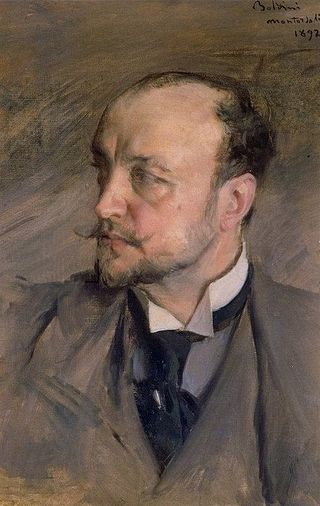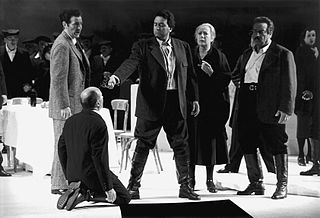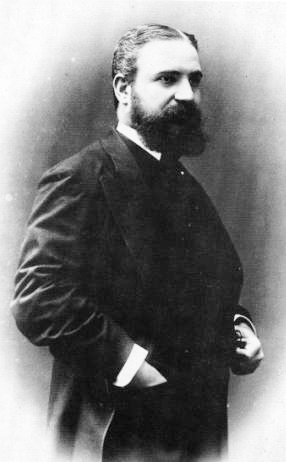
Giovanni Carmelo Verga di Fontanabianca was an Italian realist (verista) writer.

The Florio family was a prominent entrepreneurial Italian family who started many lucrative activities in Sicily involving the export of Sicilian products in the 19th century, in some ways redeeming Sicily from feudal immobility. The family extended its interests to shipping, shipbuilding, fisheries, mining, metallurgy and ceramics. The Florio economic dynasty was one of the wealthiest Italian families during the late 19th century. In the heyday of the Florio business empire reportedly some 16,000 people depended on the family, and the press sometimes referred to Palermo as 'Floriopolis'.

The Teatro Massimo Vittorio Emanuele is an opera house and opera company located on the Piazza Verdi in Palermo, Sicily. It was dedicated to King Victor Emanuel II. It is the biggest in Italy, and one of the largest of Europe, renowned for its perfect acoustics.

Giovanni Boldini was an Italian genre and portrait painter who lived and worked in Paris for most of his career. According to a 1933 article in Time magazine, he was known as the "Master of Swish" because of his flowing style of painting.

Lorenzo Ferrero is an Italian composer, librettist, author, and book editor. He started composing at an early age and has written over a hundred compositions thus far, including twelve operas, three ballets, and numerous orchestral, chamber music, solo instrumental, and vocal works. His musical idiom is characterized by eclecticism, stylistic versatility, and a neo-tonal language.
The Acqui Award of History is an Italian prize. The prize was founded in 1968 for remembering the victims of the Acqui Military Division who died in Cefalonia fighting against the Nazis. The jury is composed of seven members: six full professors of history and a group of sixty (60) ordinary readers who have just one representative in the jury. The Acqui Award Prize is divided into three sections: history, popular history, and historical novels. A special prize entitled “Witness to the Times,” given to individual personalities known for their cultural contributions and who have distinguished themselves in describing historical events and contemporary society, may also be conferred. Beginning in 2003 special recognition for work in multimedia and iconography--”History through Images”—was instituted.

Marco Betta is an Italian composer.

The Opera dei Pupi is a marionette theatrical representation of Frankish romantic poems traditionally performed in Sicily, Italy.

Salvatore Giuliano is an opera in one act by Lorenzo Ferrero to an Italian-language libretto by Giuseppe Di Leva, which was conceived to be performed in tandem with Pietro Mascagni's Cavalleria rusticana. The work was commissioned by the Teatro dell'Opera di Roma and premiered there on 25 January 1986.

Rocco Lentini was an Italian painter, noted for directing the team responsible for the ceiling decorations of the Teatro Massimo in Palermo.
The following is a timeline of the history of the city of Palermo, Sicily, Italy.

Fisichella is an Italian noble family, forming part of the Sicilian nobility. Members of the family include multiple judges and prelates, among them a justice of the Supreme Court of the Kingdom of Sicily and an archbishop of the Roman Catholic Church.

Franca Florio, born Francesca Paola Jacona della Motta dei baroni di San Giuliano and commonly called Donna Franca, was an Italian noblewoman, socialite and a prominent protagonist of the Belle Époque. Descendant of a Sicilian noble family, she married the entrepreneur Ignazio Florio Jr., member of the wealthy Florio family. She was nicknamed "Queen of Palermo".

Ignazio Florio Jr. was an Italian entrepreneur, heir of the rich Florio economic dynasty, one of the wealthiest Italian families during the late 19th century.

Ignazio Florio Sr. was an Italian entrepreneur and politician, member of the rich Florio economic dynasty, one of the wealthiest Italian families during the late 19th century.

Vincenzo Florio Sr. was an Italian entrepreneur and politician, member of the rich Florio economic dynasty, one of the wealthiest Sicilian families during the late 19th century.

The Baths of the Rotonda are the remains of one of several Roman public baths in the city of Catania, Sicily. Built between the 1st and 2nd century CE, they are not far from the Roman theatre and the Odeon. In the Byzantine era, the church of Santa Maria della Rotonda with its characteristic dome was built upon the remains of the Roman baths. Its walls are still covered in medieval and baroque frescoes.

The Portrait of Donna Franca Florio, or Portrait of Mrs. Franca Florio, is an oil on canvas painting by Italian painter Giovanni Boldini. The original work was created in 1901, however it was retouched several times, until the current version, signed and dated in 1924. Since 2017, the painting is in exhibition in the Palazzo Mazzarino, in Palermo.

Giovanni Antonio Riso (Notarbartolo) (1836-1901), Baron of Colòbria, was a Sicilian patriot active in the Unification of Italy and scion of one of the wealthiest families in 19th-century Palermo Sicily.















